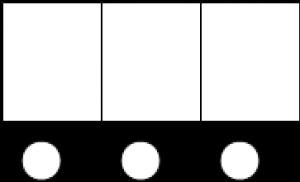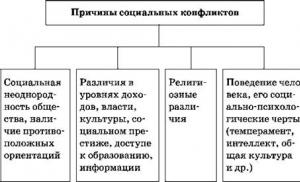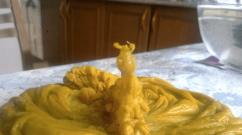What is plasticine from what it is made of. Making plasticine at a factory - how to make it yourself
Plasticine sculpting is one enjoyable and rewarding activity. Making a variety of figurines and crafts contributes to the development of creative thinking, fine motor skills and speech of the child. Today, plasticine can be purchased at any children's goods store, but it is better to make it at home. This will save money and provide your child with an environmentally friendly toy that does not contain toxic substances.
Types of playdough for children you can make at home
Homemade plasticine is the best safe game for your little one
At home, you can make both ordinary and smart plasticine - hendgam.
Smart plasticine has many interesting properties:
- This modeling mass can be liquid and solid at the same time. If the handgam is placed on a flat surface, after a few minutes it will spread and become like a puddle. With a sharp impact, the mass hardens.
- If plasticine is thrown on the floor, it will jump. It can be pulled, torn, kneaded.
- Handgam translates as "hand gum". It does not stain, does not stick to things, hands, walls, ceilings. After using smart plasticine, there is no need for cleaning.
- When the temperature changes, it takes on a different color.
- The composition of the mass does not include harmful substances, it has no taste or smell. Classes with such manual chewing gum will be interesting not only for children, but also for adults.
Handgam is suitable for children from three years old and older. It consists of safe components, but this mass cannot be tasted and glued to the body. With children who have not reached the age of three, it is recommended to practice using ordinary plasticine.
Thermal manufacturing method
This method involves heating the components to facilitate mixing.
Classic plasticine recipe for children
You will need:
- 2 glasses of water;
- 1 tablespoon vegetable oil;
- 2 cups of flour;
- 1 cup fine salt
- 1 tablespoon citric acid
- food coloring.
Step-by-step instructions for making ordinary plasticine
The process looks like this:
- Pour water into a saucepan, then vegetable oil, dye and put on fire.
- When the mixture comes to a boil, remove it from the stove.
- In another container, combine flour, citric acid and salt.
- Pour hot water and oil into the mixture.
- Mix the mixture until smooth. Make sure that there are no lumps left. The mixture should be soft and moderately sticky.
- Now you can cut the plasticine into fragments and paint each in a separate color.
Alum variant
Homemade plasticine with the addition of alum does not require special costs
For the second method, prepare:
- 2 tablespoons of oil;
- 1/2 cup salt
- 2 tablespoons of alum
- dye;
- 2 cups of flour.
The cooking instructions are as follows:
- Pour water into a container and place on the stove, add salt.
- When the salt has dissolved, remove the pan from the heat.
- Add alum, color, flour and oil to salt water. Stir the prepared mixture. Chilled plasticine can be used for its intended purpose.
Lazy plasticine
This recipe does not involve a lot of ingredients and is great for beginners.
For this method you will need:
- 1 glass of water;
- 1 glass of salt;
- dye;
- half a glass of flour.
Scheme for the preparation of plasticine from water, salt and flour
The preparation method is as follows:
- Mix all the ingredients in a saucepan, place it on fire.
- Cook until the mixture is firm.
- Remove the mixture from the stove and refrigerate.
- When the dough has cooled, knead it, adding additional flour.
- The mass should acquire the consistency necessary for modeling.
Gluten Free Plasticine
Plasticine made without adding flour is suitable even for children with allergies
This recipe is perfect for children with gluten allergies. It does not involve the use of flour, therefore it excludes the child's contact with an unwanted substance.
For the fourth method, prepare:
- 1 cup cornstarch
- 2 glasses of baking soda;
- 1.5 cups of water;
- dye.
The cooking process is as follows:
- Combine baking soda, cornstarch, water, and color in a saucepan.
- Put the container on fire. Keep the mixture on the stove until it thickens.
- When the plasticine has cooled, it must be thoroughly kneaded.
How to make a cold sculpting mass
If it is not possible to heat the plasticine mass, then you can use the cooking options without heat treatment.
Classic salted dough
Salted modeling dough - a cheap and practical option
Salted dough is widely used for making crafts of various difficulty levels. Children of any age can work with it. Such plasticine is made from natural ingredients that can be found in every home.
Important! Such a mass for modeling is made on the basis of natural products, if a child pulls it into his mouth, it will not harm his health.
To make salted modeling dough, you need to prepare:
- 250 ml of water;
- 1 glass of Extra salt;
- 2 cups wheat flour.
The cooking process is as follows:
- Combine salt and flour in a bowl.
- Then gradually add water and knead the dough.
- To determine the degree of readiness of the plasticine mass, focus on its structure. If the mixture crumbles, add a little water. Pour flour into too sticky plasticine.
- Form a ball from the prepared mass, make several indentations in it with your fingers. If the dough holds its shape and does not blur, it is done.
While mixing, you can add a little vegetable oil. Thanks to this component, the plasticine will not dry out, stick to your hands, and a crust will not form on it.
Important! It is necessary to correctly determine the amount of oil, if you add too much of it, the clay will begin to attract dirt and will dry for a long time.
Video: a practical guide to making salt dough
Oatmeal recipe
The second option will require the preparation of the following ingredients:
- 1 glass of water;
- 1 cup flour;
- 1 cup oatmeal
- Place all ingredients in a bowl.
- Mix the ingredients until smooth.
Option with honey
Prepare the following components:
- 6 tablespoons of honey;
- 2 cups peanut butter
- skimmed milk powder.
- Combine honey and peanut butter in a container.
- Add milk powder and knead until the mixture acquires the consistency of soft plasticine.
Step-by-step instructions for creating smart plasticine
Smart plasticine will undoubtedly please the child
Handgam can be prepared in many ways. But not all of the existing options involve the creation of safe plasticine. Some recipes include sodium tetraborate. Plasticine containing this component is not suitable for small children. You can make a safe mass using the following recipes.
PVA and starch handgam
Handgam is an interesting material for games and sculpting
You will need:
- 0.25 cups of PVA glue;
- 1/3 cup starch
- dye;
- small package.
The technique is as follows:
- Pour starch into the bag, add dye.
- Pour in the glue and shake. A lump should form from the components.
- Take it out of the bag and wait for the liquid to drain. After that, the clay will be ready for use.
PVA and soda hand gum
Required components:
- 50 ml of PVA glue;
- 2 tablespoons of baking soda
- glass jar;
- dye;
- plastic bag.
Do the following manipulations:
- Combine the glue and dye in the jar.
- Add baking soda in small portions and stir. You should have a mass that looks like shortbread dough to the touch.
- Then take the plasticine out of the jar, place it in a bag and knead it. When the mass turns into a homogeneous lump, it can be used for sculpting.
Video: making a handgum from soda and PVA
Clever plasticine made from cornstarch
You will need ingredients such as:
- 1 glass of warm water;
- 2 cups cornstarch
- dye.
- Pour starch into the water in small portions and stir thoroughly.
- Add dye. The finished plasticine should visually resemble mucus.
Important! Do not use cold water, it will make it difficult to stir the starch. It must be warm.
How to make plasticine from starch - video
Washing powder recipe
Ingredients:
- 50 ml of PVA glue;
- a small amount of washing powder.
- Pour glue into a container, add powder.
- Mix the resulting mixture thoroughly. It should acquire a gel-like consistency.
Starch and hair conditioner hendgam
You will need the following components:
- 200 g of potato starch;
- hair conditioner
Cooking instructions:
- Pour the starch into a bowl and add hair conditioner.
- Knead the mixture until smooth, adding conditioner if necessary.
Hair conditioner can be replaced with shampoo, but this will require more starch.
Video instruction for making a handgam
How to paint plasticine at home
Dye options for plasticine
For coloring homemade plasticine, use:
- gouache;
- acrylic paints;
- artificial and natural food colors.
The safest option is the latter. Plasticine is painted with beet or carrot juice, as well as turmeric and coffee:
- To give the elastic mass the desired color with the help of root crops, they must first be grated on a fine grater.
- Then put the resulting mass on a piece of cheesecloth and squeeze out the juice. The natural dye is ready.
- Liquid colorant is added at the very end of making plasticine.
Dry foods such as coffee or turmeric are added during the elastic blend process along with the rest of the ingredients. Then the mass is mixed well so that it acquires a uniform color.
Ordinary plasticine is stored in a tightly closed container or cling film. You can put it in the refrigerator and warm it up a little before use. But the temperature level in this case should not exceed 40 ° C. If moisture appears on the surface of the mass, add a little flour.
Smart plasticine must be stored in a bag. It should not be exposed to heat and water. Also, do not put the handgums in the refrigerator. If all conditions are met, hand gum retains its properties for five years.
According to its characteristics, homemade plasticine is not inferior to store products. It does not contain synthetic substances that can provoke allergic reactions in a child, therefore it is completely harmless to his health. In addition, it can be produced in unlimited quantities. Such plasticine is suitable both for creative games with children and for professional modeling.
We all know perfectly well what it is, but few know how and from what plasticine is made. Now we will take a closer look at the composition and production technology of plasticine.
WHAT IS THE ARTICLE ABOUT?
Plasticine composition
The composition of modern plasticine includes the following main components:
- Petrolatum
- Kaolin (clay)
- Paraffin
- Rosin
- Zinc white
- Pigment component
Now let's take a closer look at each component.

Petrolatum - a mixture of paraffin, ceresin and oil
Kaolin - white clay
Rosin - the solid part of resinous substances in conifers of trees, which remains after the removal of volatile substances from them - turpentine
Zinc white - zinc-based white pigments, which, when combined with binders (drying oil, vegetable oil), form white paints.
Pigment component- dye
Plasticine production at the factory

Most of the time of the plasticine production technology, all components are thoroughly mixed. To begin with, petrolatum, paraffin and rosin are heated and added to a large reactor boiler, which in turn is heated by steam. Also at this stage, zinc white is added in order for the main pigment to better color the entire mixture. All this is mixed and kaolin (clay) and a pigment component are gradually added there.
Now all this hot mixture will be mixed for a whole hour and a half, until an absolutely uniform mass is achieved. Then all this mixture is poured into a hopper for cooling. In this hopper, a drum rotates, which is cooled from the inside. He immerses himself a little in plasticine and winds a solid tape around himself, which freezes almost instantly.

Further, this tape enters the auger press and comes out of it already with bars of the usual plasticine with a wavy top surface. This procedure takes place in parallel for each color, after which they all meet on a common conveyor, where they are distributed among the packages.
The finished plasticine is also being tested. Check as follows: first, knead it for 3 minutes and make a sausage with a diameter of 1 centimeter, then bend it into an angle of 90 degrees, under such conditions, no cracks should form on the bend. Also, plasticine should not be sticky, should not stain water and tear.
Types of plasticine

I would like to note that there are a large number of types of plasticine. I'll tell you more about the most popular of them.
Classic plasticine- This is plasticine based on paraffin and chalk. This is domestic plasticine, which we all know.
Wax plasticine- the name speaks for itself. Softer than the classic, so it is now more popular with children.
Sculptural plasticine- a harder look. The main use is to create sculptures for exhibitions. Available in 3 colors - gray, green, flesh. After creation, the shapes are usually painted.
Ball plasticine- the target audience of this species is the youngest children. Made from a variety of balls connected by special adhesive bonds. Outstanding crafts will not work, but it helps very well to develop the motor skills of young children.

Floating plasticine- two times lighter than usual, which is why it has such a name.
Smart plasticine - has a liquid and solid form, does not stick, stretches, breaks. When interacting quickly, it behaves like a solid object, but over time it looks more like a liquid.
How to make plasticine at home?

In order to make plasticine at home you will need:
- 2 cups of flour
- 1 glass of salt
- 1 glass of water
- 1 tablespoon vegetable oil
- 1 tablespoon starch
- food coloring or gouache
- PVA glue
First, mix the flour, salt and starch in a container a little. Dilute dye or gouache, vegetable oil and PVA glue in water. Gradually add this mixture to the flour and mix thoroughly. You should have a very firm dough.
How to make smart plasticine with your own hands?

The most important thing that you need to create smart plasticine at home is PVA glue and sodium tetraborate. Sodium tetraborate is sold in every pharmacy and costs a penny. It is also recommended to add some kind of pigment, it can be like a food coloring, it can be gouache or even brilliant green. The cooking process itself will not take much time. Pour PVA glue into a convenient container and mix with your dye until a mass homogeneous in color, then gradually add sodium tetraborate, keep in mind that the more it is, the thicker and denser your “smart” plasticine will be.
plastilina, from ancient Greek. πλαστός - stucco) - material for sculpting. Previously made from refined and crushed clay powder with the addition of wax, animal fats and other substances that prevent drying. Currently, in the production of plasticine, high-molecular-weight polyethylene (HMPE), polyvinyl chloride (PVC), rubbers and other high-tech materials are also used. It can be painted in various colors. Serves for making figures of sketches for sculptural works, small models, works of small forms.
The question of who is considered the inventor of plasticine is controversial. In Germany, they are considered Franz Kolb (patent 1880), in Great Britain - William Harbut (patent 1899). There is another version of the creation of plasticine, according to which this substance was invented by Joe McVicker. Initially, plasticine was to be used to remove stains from wallpaper. A relative of McVicker, who worked in a kindergarten, received a parcel with plasticine, showed it to the children, who appreciated it, and after a while, plasticine began to be used everywhere, displacing clay, which was previously preferred.
Plasticine is used by children as a material for crafts. Play dough helps to develop finger coordination. For children's creativity, it is desirable to use safe plasticine made on a plant basis.
Smart plasticine
Smart plasticine, or as it is also called - hendgam (literally - hand gum, English), this silicone-based substance, to the touch resembles chewing gum, but has interesting properties of thixotropic liquids. Due to this, it flows, breaks, breaks, etc. Due to other components, it can still magnetise, glow, change color. Tar has similar properties at relatively low temperatures.
Sculptural plasticine
Sculptural plasticine is used for more serious modeling tasks. It keeps its shape better, allows to work out rather small details of the sculpture. Plasticine is distinguished by its special elasticity. This property allows you to use it for sculptural miniatures and modeling work. Does not leave stains and does not stick to hands and special materials used in the work. The shelf life of plasticine is not limited: it retains its properties for a long time, so it can be used for many years. For the manufacture of sculptural plasticine, a waxy mass is used with the addition of mineral pigments and fillers.
Disadvantages of plasticine
- Fading in the light;
- contamination of hands due to working with plasticine;
see also
Sources of
- Vatagin V. How to sculpt animals// Painter. 1962, No. 5. P.53-56.
Links
Wikimedia Foundation. 2010.
Synonyms:See what "Plasticine" is in other dictionaries:
- (Italian plastilina from the Greek plastos molded), material for molding. It is made from refined and crushed clay powder with the addition of wax, lard and other substances that prevent drying. It can be painted in various colors. Serves to fulfill ... Big Encyclopedic Dictionary
- (or plasticine), plasticine, many others. no, husband. (from the Greek plastos molded) (special). A mass of clay with some impurities that prevent it from drying out, votr. for modeling. Ushakov's explanatory dictionary. D.N. Ushakov. 1935 1940 ... Ushakov's Explanatory Dictionary
PLASTILIN, a (y), husband. Plastic material for modeling, consisting of clay and wax with the addition of fats, petroleum jelly and other substances that prevent drying. | adj. plasticine, oh, oh. Ozhegov's Explanatory Dictionary. S.I. Ozhegov, N.Yu. Shvedova. 1949 ... ... Ozhegov's Explanatory Dictionary
Present, number of synonyms: 3 material (306) plastic (31) plastic mass (4) ... Synonym dictionary
It. plaslilina (gr. plastos sculpted) is a mass consisting of clay with an admixture of substances (mainly wax, oil) that prevent it from drying out; uptr. for modeling. New dictionary of foreign words. by EdwART, 2009. plasticine of plasticine, pl. No m.… … Dictionary of foreign words of the Russian language
A; m. [ital. plastilina] 1. Plastic mass of clay with the addition of wax, oil, which prevents it from drying out, used for modeling. Plasticine box. A block of plasticine. Sculpt from plasticine. Fill the holes with plasticine. Cleanse from ... ... encyclopedic Dictionary
plasticine- 1. freshly harvested hemp pollen. Jargon of drug addicts 2. raw opium. Jargon of addicts 3. Plasticine Handcrafted soft hashish. Synonyms: plastic, handbrake, shmyakish. Jargon of addicts ... Dictionary of modern vocabulary, jargon and slang
plasticine- plastilinas statusas T sritis chemija apibrėžtis Molio miltelių, cerezino, vazelino ir kt. medžiagų plastiškas mišinys. atitikmenys: angl. plasticine rus. plasticine ... Chemijos terminų aiškinamasis žodynas
There comes a time when a kid from a young researcher "turns" into a little bit of something. Parents simply do not have time to answer his questions, which follow one after another. And then one day, after another sculpting with plasticine, the kid will ask, what is it made of? But not every adult can answer. However, many parents, especially caring mothers, also ask this question, because when you first offer something to a child, you want to be sure of the safety and environmental friendliness of toys and materials from which they are made.
So, what is plasticine made of? In order to answer this question, it is necessary to study its composition.
What is plasticine made of?Plasticine contains many ingredients. The sculpting material sold today is significantly different from what was on store shelves during the Soviet era. Then, for its production, they used mainly animal lard, which was supplemented with chemicals.
Today, there are many types of plasticine for children, differing in composition from each other. However, in most cases these are:
- crushed clay powder;
- beeswax;
- animal fat;
- ceresin;
- color dyes - pigments;
- petrolatum.
The latter helps to prevent the drying of plasticine, so it remains soft and plastic for a long time.
Recently, the so-called has become very popular. It is made from the same thing as plasticine, with the only difference that more lubricants (derivatives of petroleum jelly and glycerin) are used for its production, which prevent rapid drying. That is why, after working with such material, children's hands are always greasy. Another type that is just gaining popularity is. It consists of lightweight foam balls, which are bonded together with an adhesive. This substance is made on the basis of glycerin, or a special hardening gel (hardening plasticine).
What to look for when buying plasticine?The first thing to do, picking up the plasticine packaging, is to pay attention to what it is made of. If any information about the composition is missing, or available, but not in Russian, then it is better to refuse to purchase it.
Any plasticine must have a neutral odor. Its presence once again indicates that it was made from poor raw materials.  To make sure of the quality, you need to take a piece of plasticine and hold it in your hand. Normally, it should not melt, but only slightly soften, becoming plastic.
To make sure of the quality, you need to take a piece of plasticine and hold it in your hand. Normally, it should not melt, but only slightly soften, becoming plastic.
Many parents, fearing for the health of their baby, do not allow him to play with plasticine, worrying that he will accidentally bite off a piece. These worries are in vain, because plasticine is a fairly safe material. Moreover, today there are varieties of plasticine that a child can eat without health consequences. As a rule, this is indicated on the packaging.
Dear readers, hello!
Today I want to discuss with you a very interesting topic: homemade plasticine recipe. Moreover, I will tell you about the amazing properties of "smart plasticine", which is very popular nowadays. I believe that this is important for many parents whose children love to sculpt with plasticine.
Briefly about plasticine
The name "plasticine" comes from the Italian "hlastilina", from the ancient Greek "stucco", a material for modeling. Each of us is familiar with this material since childhood. It was made from refined and powdered clay, wax, animal fats and other substances that prevent drying.
Plasticine was invented in England in 1897 by W. Harbutt, an art school teacher. The industrial production of plasticine began in Germany in 1900 with the addition of dyes. For more than a hundred years, plasticine has not lost its popularity. Currently, in the production of plasticine, high-molecular-weight polyethylene, polyvinyl chloride, synthetic rubbers and other high-tech materials are used.
What is the use of a child from classes with plasticine
Medicine strongly recommends this activity. for kids, as one of the best in the development of their fine motor skills. Fine motor skills are the ability to perform fine and precise movements of the hands and fingers as a result of coordinated actions of the nervous, muscular and skeletal systems. The term sleight of hand is used here. Fine motor skills are very important as they are related to the nervous system, visual system, attention, memory and perception of the child. Scientists argue that fine motor skills contribute to the development of speech, since the motor and speech centers in the brain are very close to each other. Therefore, stimulation of the motor center leads to the activation of the speech center.
Pictures are clickable!
My son started modeling at the age of 1. I saw how this activity helped him learn about the world around him. Currently, my boy is already 4 years old and sculpting is his favorite business. He built garages from plasticine with various brands of cars and various equipment; palaces with kings, knights, princesses and a strategy for their defense; cuisines with a variety of culinary delights. He is very fond of sculpting animals, flowers and much more.
It is difficult to imagine how many different types of plasticine we used for these "works", not to mention the prices. Our grandmother did not like this material very much, as it polluted the premises and was difficult to clean (sometimes greasy, sometimes very sticky, sometimes crumbling). It was she who prompted the idea to cook plasticine, comfortable for its use at home. By the way, you know
Ways of self-preparation of plasticine
At first I made plasticine just from flour and water, but it dried out quickly, was sticky when restored with water, and did not keep its shape well. Then I started looking for recommendations how to do high-quality plasticine, safe for the child, from the means at hand?
It turned out that there are many ways to make clay at home. It can be prepared:
- in a cold way,
- by heat treatment,
- edible and not edible,
- plain and multi-colored.
To give color to plasticine, you can use food coloring and even directly:
- beets - for red,
- raspberry juice - for pink color,
- red cabbage juice - for blue color,
- carrots - for orange color,
- saffron (turmeric) - for yellow color,
- spinach - for green color,
- hibiscus tea infusion - for blue color, etc.
For older children, in the manufacture of plasticine, you can also use unnatural dyes: gouache, acrylic paints.
Pictures are clickable!







Homemade plasticine recipes
Play up
The recipe for homemade Play Do plasticine in the article Follow the link to find recipes for a beautiful, bright, elastic, just harmless Play Do plasticine, which is in no way inferior to the original. Store Play Do in a closed container in the refrigerator.
Salty dough
Also, I have already told you the recipe for plasticine, which is called salted dough. This dough is used as a self-hardening clay. Sculpt the figures and leave to dry. More details,
Classic plasticine
Ingredients:
- salt - 2 tbsp. l.
- flour - 1 glass
- cold water - 1 glass
Mix all the ingredients well with a spoon, then put on a chopping board, sprinkled with flour, and knead the mass until plastic is convenient for sculpting. Store in a closed jar or cling film.
By heat treatment.
Components:
- flour - 1 glass
- salt - ¼ glass
- vegetable oil - 1 tbsp. l.
- warm water - ½ glass
Combine water and vegetable oil and bring this mixture to a boil. Mix flour and salt and gradually add to boiling liquid. While stirring, cook over low heat until a ball forms. Then, sprinkle the board with flour, knead the mass until it stops sticking to your hands and becomes elastic. Now the mass can be divided into several parts and, adding a few drops of food coloring of different colors to each, knead well again. That's it - homemade plasticine is ready!
Homemade plasticine that glows in the dark.
Components:
- flour - 2 cups
- salt - 2/3 cup
- warm water - 2 glasses
- vegetable oil - 2 tbsp. l.
- vitamin B - 2 tablets
- tartar (sold in the spice department) - 4 tsp
Grind vitamin B into powder, add flour, salt, tartar and mix well. Pour in water and vegetable oil and mix with a spoon without lumps. Cook this mass over medium heat until it stops sticking to the pan and spoon and looks like plasticine in appearance. After cooling, shape the homemade clay, turn off the light and turn on the ultraviolet lamp. Plasticine will glow in the dark. Honestly, we have not done this yet, have not tested it.
Shaving foam
You can make homemade plasticine foam for shaving.
Ingredients:
- shaving foam (I took ARCO)
- potato starch
- vegetable oil
We made this plasticine with our four-year-old son, it was very interesting and fun for us. First, squeeze about 3 tablespoons of shaving foam from the tube into a deep bowl, then add a little dye (gouache) of any color to it and stir. Add starch over a dessert spoon and mix until the consistency of plasticine is formed. Transfer to the board add ½ tsp. vegetable oil and knead until a plastic mass is obtained. Now you can sculpt any figures.
The disadvantages of this plasticine:
- starch contamination of hands (but it is easily washed off),
- not everyone will like the smell of shaving foam.
Many people know such a product of the American company Hasbro as Play Doh baby mass for modeling. This plasticine was invented in 1956 as a wallpaper cleaner. It is elastic, pleasant to the touch, has bright colors and is positioned by manufacturers as absolutely safe. The exact composition of Play Do plasticine is a trade secret, but it is known to be mainly made up of flour, salt, wheat and water. However, the price of this plasticine is very high. It's easier, cheaper and more interesting to make Play Do plasticine do it yourself at home.
Plasticine from starch and hair balm.
Soft, pleasant to the touch, holds its shape well and smells great homemade plasticine from starch and hair balm.
Components:
- potato starch - ½ cup
- hair balm - ¾ glass
Stir the ingredients well in a bowl, then put on a board and knead until the consistency of plasticine. You can add food coloring and a drop of essential oil.




Popular plasticine hendgum
Scottish scientist James Wright in 1943 invented the amazing substance "Hendgam", which literally translated from English. means "hand gum" or hand gum. It was obtained as a by-product in experiments carried out by the scientist to obtain synthetic rubber. This plastic toy is named "Smart plasticine"... Hendgam is the best toy for children and adults all over the world. In 2009, an international jury recognized smart plasticine as the “best gift of the year”.
For a long time, the miracle composition was classified. Later it became known that smart plasticine consists of 65% organosilicon polymer (silicone), 17% crystalline quartz, 9% castor oil, 1% glycerin and other minerals of natural origin. It is completely non-toxic, harmless, odorless and tasteless.
Smart plasticine has unique properties:
- does not stick to hands,
- can glow in the dark,
- can change color,
- can magnetise,
- can be transparent,
- does not heat up in the microwave,
- sinks but does not dissolve in water,
- leaves no traces
- you can print a photo on it,
- does not dry out
- takes any form,
- does not get dirty
- easy to mix (any colors).
Depending on the intensity of the kinetic effect in short periods of time, smart plasticine behaves like a solid body: it stretches like rubber; tears like paper; jumps off the floor like a ball; breaks into fragments when hit hard with a hammer, like porcelain; they can hammer in a nail. In long intervals of time, it manifests itself as a liquid (for example, a ball of smart plasticine spreads over the table), flows through the holes in large drops.
The usefulness of smart plasticine:
- promotes the development of fine motor skills of the hands;
- strengthens the muscles of the arms;
- develops creative thinking;
- perfectly massages palms and fingers, gently affecting certain points, stimulates and normalizes the work of internal organs;
- relieves fatigue, irritation, stress and aggression;
- positively affects the activity of the brain;
- bright colors - energize, fill with joy;
- pastel colors - give peace, bliss and harmony.
Disadvantages of smart plasticine: do not stick to hair and prevent spreading on carpets, fabrics, equipment, keyboard to avoid cleaning with alcohol (natural products) or solvent (synthetic products); reacts with chemicals.
Once, such a handgam stuck to the hair of a girl who was our guest. We managed to wash it off with warm water and soap, but we washed it for a very long time and pulled out a little hair. It took at least half an hour to wash. Here he is such a clever plasticine.
Clever plasticine recipe
Ingredients:
- PVA glue - 100 grams
- sodium tetraborate (borax on glycerin, sold in a pharmacy) - about 1 tsp.
- food coloring (preferably liquid) - 3-5 drops.
Squeeze the glue into a glass container, add the dye and stir with a wooden stick until the color is uniform. Add borax in glycerin and stir until thick. Stir gently to avoid getting the borax in your eyes.
For a more fluid handgum, add some toothpaste to the glue. More details in our video.
Store in a closed container. So clever plasticine is ready. After 2-3 days, he acquires all the qualities inherent in American-made plasticine.
Edible plasticine
And finally, edible plasticine, as confectioners call it - mastic. Remember the figurines on the birthday cakes? They are made of mastic, which is molded like plasticine. So now you and your child can decorate the birthday cake yourself.
Plasticine from Marshmello
Plasticine from powdered sugar and gelatin
Good luck in joint creativity, happiness and harmony to your families!
Marshmallow plasticine
Sincerely, Elena.
I really look forward to your responses. Thank you in advance.
Come back, it will be interesting.













